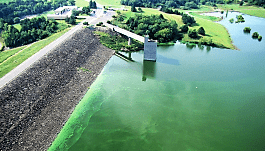Kansas partnership improves source water, boosts agriculture operations
May 3, 2023

AWWA Articles
Kansas partnership improves source water, boosts agriculture operations
For more than a decade, harmful algal blooms have plagued Milford Lake in north central Kansas each summer.
 The water in the state’s largest manmade lake turns green, milky, filmy, stinky. Fish float belly-up, and pets or other wildlife can die after swimming in the toxins. Airborne particles become a respiratory worry for people on boats and treating the water in the lake that serves one-third of all Kansans becomes a nightmare.
The water in the state’s largest manmade lake turns green, milky, filmy, stinky. Fish float belly-up, and pets or other wildlife can die after swimming in the toxins. Airborne particles become a respiratory worry for people on boats and treating the water in the lake that serves one-third of all Kansans becomes a nightmare.
“Going out to a lake with an algae bloom, it becomes very evident, very quickly, that this is not water you want to be around,” said Jerry Koukol, communication specialist with WaterOne, the largest water utility in Kansas.
But a major public-private partnership, known as the Milford Lake Watershed Regional Conservation Partnership Program (RCPP), aims to change that.
“It’s a positive partnership all around,” Koukol said. “Agricultural producers are getting targeted funding to improve watershed areas we’re concerned about, and it’s having a measurable impact downstream.”
More than 98% of land in Kansas is privately owned, and farms and ranches compose almost all of Milford Lake’s 1.25-million-acre watershed.
Excess nutrients from fertilizer and livestock operations eventually wash into creeks and streams that feed the lake, causing harmful algal blooms. Improving soil health and preventing nutrient pollution will go a long way in improving water quality, officials say.
“We want to do everything we can to reduce nutrient runoff and pollution while improving agriculture operations,” Koukol said.
The partnership has paired 33 stakeholders — from campgrounds to the Kansas Soybean Commission — to provide financial and technical assistance for voluntary conservation projects that will reduce nutrient pollution in Milford Lake’s watershed.
Led by the Kansas Water Office and the Natural Resources Conservation Service (NRCS), it’s the largest effort ever undertaken in the state to implement harmful algal bloom conservation practices, Koukol said.
 WaterOne, a founding partner located 150 miles downriver, serves 480,000 customers in eastern Kansas, and was an early proponent of the RCPP model.
WaterOne, a founding partner located 150 miles downriver, serves 480,000 customers in eastern Kansas, and was an early proponent of the RCPP model.
“We’re all affected,” Koukol said. “We all share the same resources. And these are relationships we’ll need down the road. A public-private partnership is core to having any measurable impact.”
The five-year program includes a $2.8 million grant from the NRCS and $2.4 million of cash and in-kind support from the partners. The state’s goal is to prevent 650,000 pounds of phosphorus from entering Milford Reservoir each year, said Andrew Lyon, director of conservation with the Kansas Department of Agriculture Division of Conservation. Because this effort is still in its implementation stage, he said, it’s difficult to quantify how much phosphorus loading has been reduced with this program.
But the real success, Lyon said, is the partnerships that have been built, the focus on best practices and the long-term commitment to improving Milford Lake’s watershed.
Now agriculture producers are implementing those best practices, such as planting cover crops, installing fences to keep livestock away from streams, and adjusting how and when they apply fertilizers and other nutrients.
During the original term of the partnership, all NRCS funds were obligated within the first two years. The program has been renewed for another five years and will promote the most effective practices to capitalize on the partnership’s success, said Ellen Parker, associate attorney for WaterOne.
“Protecting source water is a complex issue,” Parker said. “Getting the number of stakeholders involved in the RCPP all rowing in the same direction is a big accomplishment that will hopefully lead to future collaboration as different opportunities for source water protection emerge.”
The American Water Works Association advocates for these types of projects to be included in the federal farm bill, and is working with lawmakers to ensure funding in the 2023 version. In fact, a Journal AWWA article about the farm bill sparked the effort at WaterOne.
“I don’t think this project would’ve been possible without the farm bill,” Koukol said. “These resources are essential for enabling projects like this, and they go such a long way in making a difference in regional water quality.”
Koukol encouraged other utilities to contact WaterOne for more information about the regional partnership.
“This is such a great way to leverage dollars and get more miles out of your conservation effort, rather than waiting to react to problems as they come up,” he said. “And it’s not just about improving water quality. It improves the entire ecosystem and is a business enhancement for agriculture producers.”
Advertisement